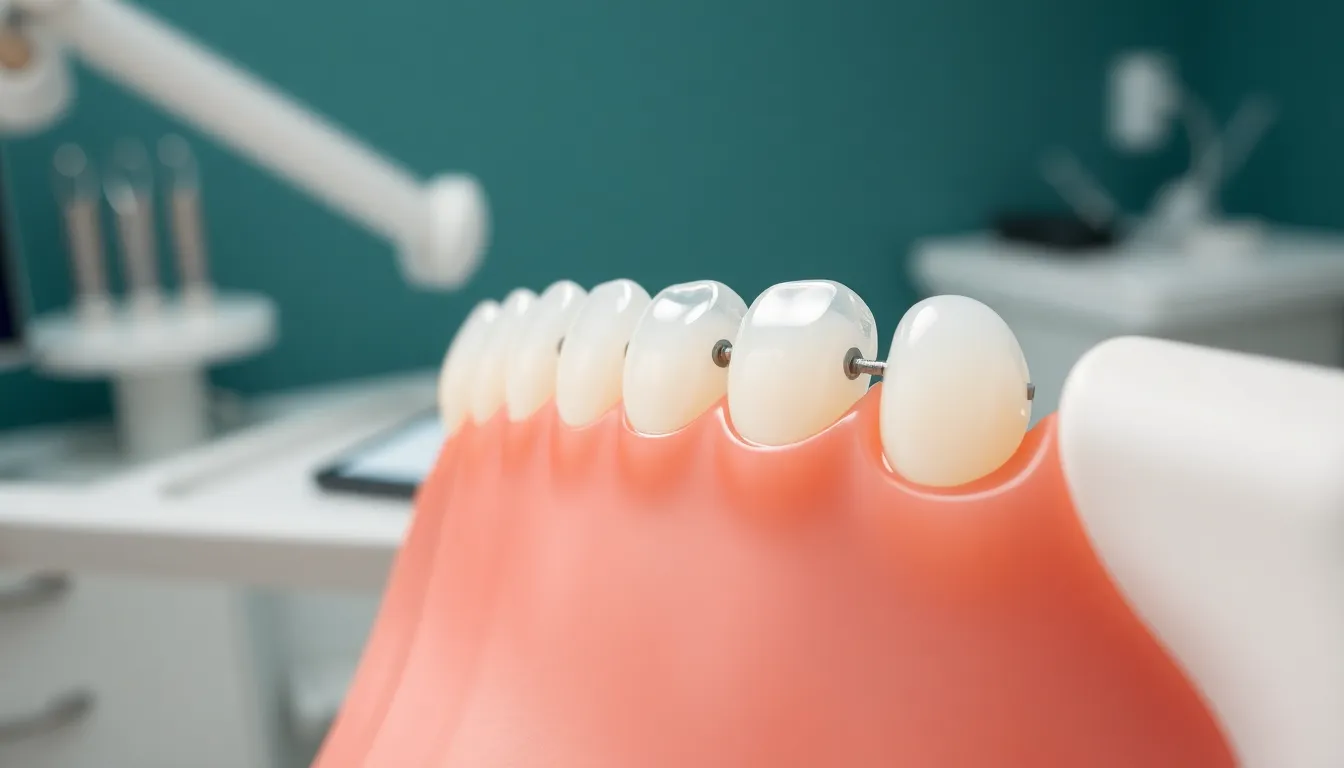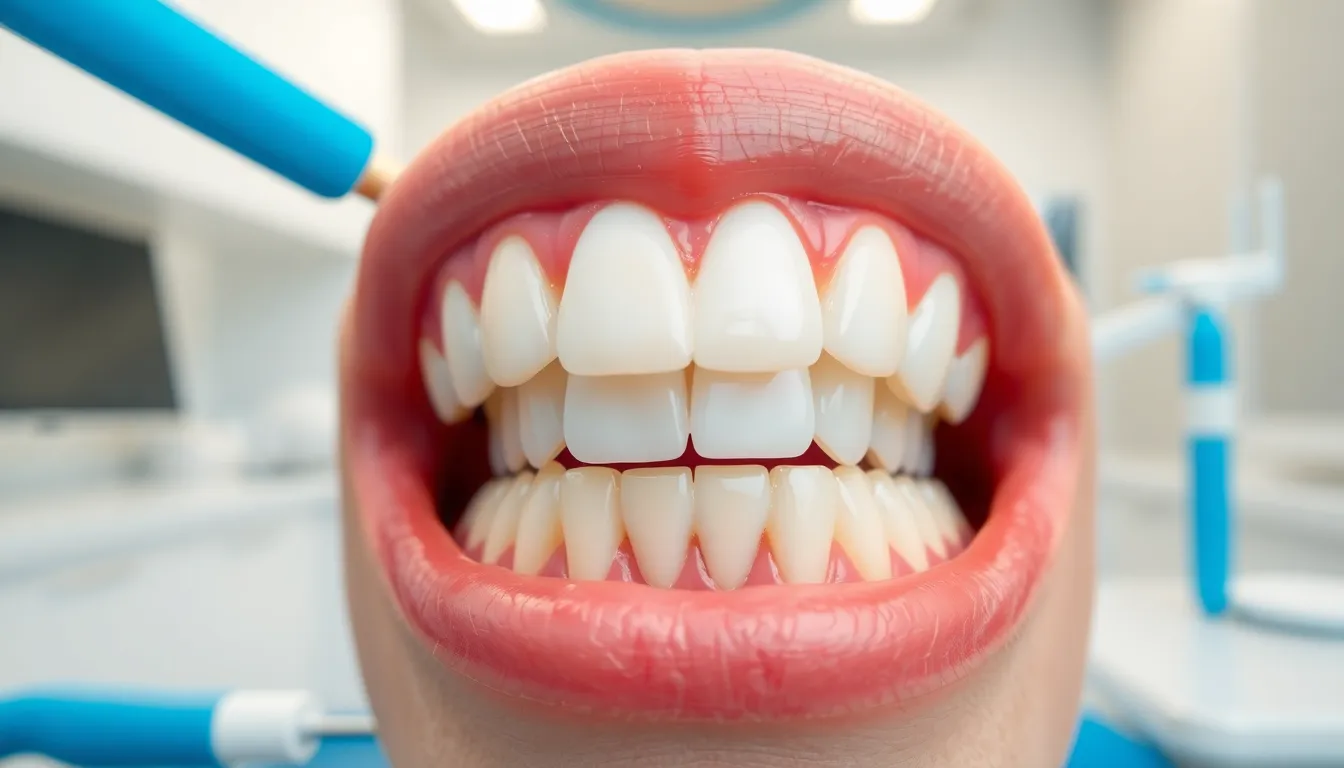Considering ceramic braces for your orthodontic treatment? These discreet alternatives to traditional metal braces have become increasingly popular among adults and teens seeking a more aesthetic smile correction option.
Ceramic brackets blend with your natural tooth color, making them less noticeable while still effectively straightening your teeth. They’re made from durable materials that resist staining and provide the same effective results as metal braces. If you’re concerned about your appearance during orthodontic treatment but want reliable results, ceramic braces might be the perfect solution for your smile transformation journey.
What Are Ceramic Brackets?
Ceramic brackets are orthodontic devices made from translucent or tooth-colored materials that blend with your natural tooth color. They function similarly to traditional metal braces but offer a more aesthetically pleasing alternative for patients concerned about the appearance of their orthodontic treatment.
Types of Ceramic Brackets
Ceramic brackets come in several variations to suit different patient needs. Clear ceramic brackets provide maximum transparency, allowing your natural tooth color to show through. Tooth-colored brackets match the shade of your teeth for a seamless appearance. Self-ligating ceramic brackets eliminate the need for elastics by using a built-in mechanism to hold the archwire, reducing friction and potentially shortening treatment time. Monocrystalline ceramic brackets offer superior strength and resistance to staining compared to polycrystalline options. Combination brackets feature ceramic fronts with metal bases or slots for enhanced durability while maintaining aesthetic benefits.
Dr. Harris notes, “Many of my adult patients specifically request clear ceramic brackets because they provide effective treatment without compromising their professional appearance. One executive patient told me she completed client presentations throughout her entire 18-month treatment, and most people never noticed she was wearing braces.”
How Ceramic Brackets Are Made
Ceramic brackets undergo a precise manufacturing process to ensure quality and performance. The production begins with aluminum oxide crystals formed into either polycrystalline or monocrystalline structures. Polycrystalline brackets contain many small crystals fused together, while monocrystalline brackets consist of a single crystal grown in controlled conditions for greater clarity and strength. The material gets molded into the bracket shape using injection molding techniques at high temperatures. Manufacturers apply specialized heat treatments to increase the ceramic’s strength and resilience. Some brackets receive a glazing process to enhance smoothness and reduce friction with the archwire. The final product undergoes rigorous testing for structural integrity, stress resistance, and color stability before being packaged for clinical use.
The manufacturing complexity contributes to the higher cost of ceramic brackets compared to metal alternatives. But, advancements in production technology have improved durability and decreased the brittleness that affected earlier generations of ceramic orthodontic products.
Benefits of Ceramic Brackets

Ceramic brackets offer important advantages for orthodontic patients seeking effective treatment with a more discreet appearance. These specialized brackets combine functionality with aesthetics to deliver optimal results while addressing concerns about visible braces.
Aesthetic Advantages
Ceramic brackets provide exceptional visual appeal through their translucent or tooth-colored composition. Made from polycrystalline alumina, these brackets blend seamlessly with your natural tooth color, making them virtually invisible from a conversational distance. Adults and teenagers particularly appreciate avoiding the “metal mouth” appearance commonly associated with traditional braces. Unlike metal alternatives, ceramic brackets don’t interfere with imaging tests, allowing for uncompromised diagnostic procedures during treatment. Many of Dr. Harris’s executive clients choose ceramic options specifically for maintaining a professional appearance during important meetings and presentations. “My ceramic braces were so discrete that many of my colleagues didn’t notice I was wearing them until several months into my treatment,” shares Jennifer, a marketing director and patient of Dr. Harris.
Durability and Strength
Ceramic brackets perform reliably under normal orthodontic forces even though being more brittle than metal alternatives. Research indicates they’re approximately twice as likely to fracture under heavy pressure compared to traditional metal brackets. This characteristic occasionally necessitates additional orthodontic visits for repairs or replacements, potentially extending your overall treatment timeline. Ceramic materials also present exact bonding challenges, particularly when adhered to surfaces like enamel or ceramic restorations such as zirconia. Dr. Harris notes that “while ceramic brackets require more delicate handling, advancements in manufacturing have significantly improved their durability compared to earlier generations.” Patients typically find ceramic braces more comfortable against oral tissues, causing less irritation to the inside of your mouth than metal brackets. The brackets’ smooth surface and rounded edges contribute to this enhanced comfort while effectively protecting your enamel throughout the treatment process.
Potential Drawbacks of Ceramic Brackets

Ceramic brackets offer a less visible orthodontic solution but come with several limitations you should consider before making your decision. These drawbacks primarily relate to their cost and maintenance requirements.
Cost Considerations
Ceramic brackets represent a significantly higher investment than traditional metal braces. Treatment with ceramic braces typically costs between $4,000 and $8,000, compared to metal braces which range from $3,000 to $6,000. You’ll pay at least $1,000 to $2,000 more for the aesthetic advantage of ceramic brackets. Dr. Harris notes, “Many of my patients weigh this additional expense against the confidence boost they get from less visible braces, but it’s important to understand this cost difference upfront.”
Maintenance Challenges
Ceramic brackets demand more careful attention throughout your treatment period. Their brittle nature makes them approximately twice as likely to break compared to metal alternatives, requiring you to avoid hard foods that might damage them. The elastic ties used with ceramic brackets stain easily from coffee, tea, and deeply colored foods, potentially compromising their aesthetic appeal between appointments.
Cleaning around ceramic brackets presents additional difficulties due to their size and material composition. Inadequate oral hygiene may lead to gum swelling or recession in some patients. “I’ve had patients who were thrilled with the appearance of their ceramic braces but struggled with maintaining them,” Dr. Harris shares. “One executive client found herself scheduling more frequent appointments just to replace stained ties, which she hadn’t anticipated.”
Removal of ceramic brackets also poses challenges. The debonding process can potentially damage tooth enamel, and broken ceramic fragments occasionally remain on teeth, necessitating additional cleaning procedures. Unlike metal brackets that can bend under pressure, ceramic ones might break completely, creating risks of accidental ingestion or inhalation of bracket fragments.
Ceramic Brackets vs. Other Orthodontic Options

Ceramic brackets offer a middle ground between traditional metal braces and newer clear aligner systems. These tooth-colored orthodontic options provide distinct advantages and limitations compared to alternatives, helping patients make informed decisions about their treatment path.
Ceramic vs. Metal Brackets
Ceramic brackets deliver superior aesthetics with their clear or tooth-colored appearance, making them significantly less noticeable than traditional metal braces. Their discreet look attracts many image-conscious patients, particularly adults in professional settings. Metal brackets, while more visible with their metallic gray or silver appearance, typically cost $1,000-$2,000 less than ceramic options.
Durability differences between these options are substantial, as ceramic brackets are more than twice as likely to fracture compared to their metal counterparts. This fragility can lead to additional appointments for repairs and potentially extend treatment time. Ceramic brackets also tend to be bulkier, sometimes causing more discomfort and making oral hygiene more challenging.
Dr. Harris notes, “Many of my executive clients specifically request ceramic brackets even though the higher cost. They tell me the confidence they maintain during important meetings and presentations is well worth the investment.”
Ceramic brackets offer valuable benefits for patients undergoing imaging tests like MRIs, producing minimal signal disruption compared to metal alternatives. Treatment speed varies between options, with metal brackets generally moving teeth faster because orthodontists can apply more aggressive forces without fear of bracket breakage.
Ceramic vs. Clear Aligners
Ceramic brackets and clear aligner systems like Invisalign serve different orthodontic needs and patient preferences. Clear aligners offer nearly invisible treatment and the convenience of removability, allowing for easier eating and cleaning. Ceramic brackets, while more visible than aligners, remain fixed to teeth and work continuously to move teeth.
Treatment efficiency differs significantly between these options. Ceramic braces typically move teeth faster than clear aligners, especially for moderate to severe orthodontic cases. Complex bite corrections often respond better to bracket-based systems that apply consistent force.
The versatility of ceramic brackets makes them suitable for a wider range of orthodontic issues compared to clear aligners. Aligners may not effectively address certain severe cases, particularly those requiring important vertical tooth movement or complex rotations.
| Feature | Ceramic Brackets | Metal Brackets | Clear Aligners |
|---|---|---|---|
| Visibility | Low (clear/tooth-colored) | High (metallic) | Very low (transparent) |
| Cost | $4,000-$8,000 | $3,000-$6,000 | $4,000-$8,000+ |
| Durability | Less durable, prone to breakage | Very durable | No brackets, no breakage |
| Treatment speed | Moderate | Fastest | Slowest |
| Comfort | Moderate | Least comfortable | Most comfortable |
| Maintenance | Challenging (staining, breakage) | Easier | Easiest (removable) |
| Suitable for severe cases | Yes | Yes | Limited |
“I’ve had several patients switch from clear aligners to ceramic brackets mid-treatment,” Dr. Harris explains. “They appreciated the aesthetic quality of aligners but eventually needed the consistent force that only brackets could provide for their exact case. Ceramic options gave them the best of both worlds—effective treatment with minimal visibility.”
Patient compliance requirements vary between these options. Clear aligners rely heavily on patient discipline to wear them 20-22 hours daily, while ceramic brackets work continuously without patient intervention beyond regular hygiene practices.
Who Is an Ideal Candidate for Ceramic Brackets?

Ceramic brackets offer a discreet orthodontic solution for exact groups of patients. Teens and adults seeking less noticeable teeth-straightening options represent the primary candidates for these aesthetic alternatives to metal braces. These individuals typically prioritize maintaining a natural appearance during treatment while still achieving effective results.
“Many of my adult patients express concerns about how braces might affect their professional image,” explains Dr. Todd B. Harris. “Ceramic brackets provide them with confidence during business meetings and social interactions while their teeth are being corrected.”
Patients with various dental misalignments benefit from ceramic brackets, including those with:
- Misaligned teeth requiring comprehensive correction
- Overbite or underbite conditions needing adjustment
- Spacing issues between teeth
- Open bite corrections
- Unmatched dental midlines requiring alignment
- Certain periodontal conditions that can be addressed orthodontically
Individuals whose adult teeth have fully erupted make ideal candidates for ceramic braces. Treatment effectiveness increases when growth has mostly stopped, ensuring timely and predictable results. Ceramic brackets work particularly well for professional adults and image-conscious teens who’ve reached dental maturity.
Patients willing to invest in aesthetics often choose ceramic options even though their higher cost—typically $1,000 to $2,000 more than traditional metal braces. These candidates understand the importance of maintaining meticulous oral hygiene practices throughout their treatment, which typically lasts 18 to 36 months.
One executive client shared: “I hesitated to get braces at 42, but the ceramic option allowed me to continue client meetings without feeling self-conscious. They’re barely noticeable in video calls, which has been crucial for my confidence.”
Ceramic brackets suit patients who need faster treatment than clear aligners can provide, especially for complex cases requiring precise tooth movement. They’re also excellent for individuals who undergo frequent imaging tests, as ceramic materials don’t interfere with these procedures like metal components do.
The Treatment Process with Ceramic Brackets

The ceramic bracket treatment process involves several stages that transform your smile while maintaining a professional appearance. From your first appointment to the final removal, here’s what you can expect during your orthodontic journey with ceramic braces.
Initial Consultation and Fitting
Your orthodontic treatment begins with a comprehensive consultation to evaluate your teeth, bite patterns, and overall oral health. During this appointment, your orthodontist takes diagnostic records including dental X-rays, photographs, and impressions to develop a personalized treatment plan customized to your exact needs. For patients with tight spacing between teeth, spacers might be inserted between the back teeth about a week before bracket placement.
The fitting appointment itself takes 90-120 minutes, with the actual bracket placement requiring 10-30 minutes. Your teeth are thoroughly cleaned and prepared before a special retractor holds your mouth open during the procedure. After applying and rinsing off a conditioning solution, the orthodontist bonds each ceramic bracket to your teeth using specialized adhesive.
“Many of my executive clients are amazed at how quickly we can transform their appearance with ceramic brackets,” notes Dr. Harris. “The fitting process is relatively quick, but the impact on their confidence is immediate, even before their teeth begin moving.”
Once all brackets are secured, a tooth-colored or clear archwire is threaded through them and fastened with small elastic bands that match your natural tooth color. The wire ends are carefully trimmed to prevent irritation to your cheeks and gums, completing the initial placement.
Adjustment Appointments
Regular adjustment appointments form the backbone of your ceramic bracket treatment. These visits occur every 4-8 weeks and typically last 20-30 minutes. During each appointment, your orthodontist monitors progress, replaces elastic bands, and adjusts or changes the archwires to continue guiding your teeth into their optimal positions.
Each adjustment applies calibrated pressure to exact teeth, controlling the precise direction and speed of tooth movement. You’ll likely experience mild discomfort for 24-48 hours after adjustments as your teeth respond to the new pressure points.
Dr. Harris emphasizes the importance of these regular visits: “Consistency with adjustment appointments dramatically affects treatment duration. My patients who never miss an appointment often complete their treatment several months sooner than those who frequently reschedule.”
The elastic bands around ceramic brackets require replacement during these visits not only to maintain proper tension but also because they can become discolored over time. Fresh bands help preserve the aesthetic advantage of choosing ceramic brackets throughout your treatment period, which typically spans 18-36 months depending on the complexity of your case.
Caring for Your Ceramic Brackets
Maintain Proper Oral Hygiene
Oral hygiene becomes especially important when you’re wearing ceramic brackets. Brush thoroughly after every meal using a soft-bristled toothbrush and fluoride toothpaste. Position your brush at a 45-degree angle to the gum line and clean carefully around each bracket to prevent plaque buildup. Daily flossing with a floss threader or orthodontic floss removes food particles trapped between teeth and braces. An antibacterial mouthwash completes your routine by reducing bacteria and freshening breath.
“Many of my patients are surprised by how much more attention their oral hygiene routine requires with ceramic brackets,” notes Dr. Harris. “Those who commit to thorough cleaning maintain the aesthetic appeal they initially chose ceramic brackets for.”
Avoid Stain-Causing Foods and Drinks
Ceramic brackets stain more easily than metal alternatives, requiring extra caution with your diet. Coffee, tea, red wine, colored sodas, dark berries, tomato sauces, soy sauce, curries, and colored candies can all compromise the translucency of your brackets. Rinse your mouth immediately with water after consuming these items and brush as soon as possible. This simple habit dramatically reduces the risk of staining and preserves the natural appearance of your ceramic braces.
Attend Regular Orthodontic Visits
Scheduling and keeping all orthodontic appointments ensures professional cleaning and timely adjustments to your braces. Your orthodontist replaces any stained elastic ligatures during these visits, restoring the aesthetic appeal of your ceramic brackets. These clear or tooth-colored bands tend to discolor over time even when the ceramic brackets themselves remain stain-free.
Apply Comfort Care Techniques
Ceramic brackets occasionally cause irritation inside your mouth during the adjustment period. Orthodontic wax provides an effective barrier that protects your cheeks and gums from soreness or small cuts. Apply a small amount to any bracket causing discomfort for immediate relief without compromising your treatment.
Eliminate Smoking and Tobacco Products
Tobacco products significantly stain both ceramic brackets and natural teeth. Smoking undermines the aesthetic advantage that prompted you to choose ceramic brackets in the first place. Patients who avoid tobacco throughout their treatment maintain clearer brackets and healthier oral tissues.
Conclusion
Ceramic brackets offer a compelling blend of aesthetics and effectiveness for your orthodontic journey. Though they come with a higher price tag and require more careful maintenance than metal alternatives they provide that confidence boost many patients seek during treatment.
Whether you’re a teen concerned about yearbook photos or a professional maintaining your workplace image ceramic braces strike an excellent balance between visibility and performance. They’re particularly suited for those willing to invest in their appearance and commit to proper care routines.
Remember that your orthodontist is your best resource for determining if ceramic brackets align with your exact dental needs lifestyle and budget. With proper care and commitment you’ll achieve that perfect smile while maintaining a natural appearance throughout your treatment.
Frequently Asked Questions
What are ceramic braces and how do they differ from metal braces?
Ceramic braces are orthodontic devices made from translucent or tooth-colored materials that function like traditional metal braces but are less noticeable. They consist of brackets that blend with your natural tooth color, offering a more aesthetically pleasing option while providing the same effective results as metal braces. The main difference is in appearance—ceramic braces are more discreet—and in cost, as ceramic options typically cost more than metal alternatives.
How much do ceramic braces cost?
Ceramic braces typically cost between $4,000 and $8,000, which is higher than the $3,000 to $6,000 price range for traditional metal braces. This increased cost reflects the advanced materials and manufacturing processes used to create ceramic brackets. Many patients consider this additional expense worthwhile for the confidence boost they receive from wearing less visible braces during their orthodontic treatment.
Are ceramic braces as effective as metal braces?
Yes, ceramic braces are just as effective as metal braces for correcting dental alignment issues. They use the same mechanical principles to move teeth into their desired positions. However, treatment with ceramic braces may sometimes take slightly longer than with metal braces, as orthodontists might apply gentler pressure to reduce the risk of bracket breakage. Both options can successfully treat various orthodontic issues.
Who are the ideal candidates for ceramic braces?
Ideal candidates for ceramic braces are teens and adults seeking less noticeable orthodontic treatment while achieving effective results. They’re particularly suitable for people with various dental misalignments (overbites, underbites, spacing issues) whose adult teeth have fully erupted. Candidates should be willing to invest more financially in their treatment and maintain meticulous oral hygiene practices to preserve the aesthetic benefits of ceramic braces.
Do ceramic braces stain easily?
The ceramic brackets themselves are made from stain-resistant materials and generally don’t discolor. However, the elastic ties used with ceramic brackets can stain easily, especially when exposed to highly pigmented foods and beverages like coffee, red wine, and curry. Regular orthodontic appointments allow for replacement of these elastic ties, helping maintain the aesthetic appeal of ceramic braces throughout treatment.
Are ceramic braces more fragile than metal braces?
Yes, ceramic braces are approximately twice as likely to break compared to metal alternatives. While advancements in manufacturing have improved their durability, ceramic brackets remain more brittle and susceptible to damage. Patients with ceramic braces need to be more careful with their diet, avoiding hard and crunchy foods that could potentially damage the brackets.
How do I care for ceramic braces?
Proper care for ceramic braces includes thorough brushing after every meal using a soft-bristled toothbrush, flossing daily with orthodontic flossers or water flossers, avoiding stain-causing foods and drinks, and attending regular orthodontic appointments for adjustments and professional cleaning. Avoid smoking and tobacco products as they can stain both the elastic ties and your teeth, undermining the aesthetic advantage.
Can ceramic braces damage tooth enamel during removal?
There is a slightly higher risk of enamel damage during the removal of ceramic braces compared to metal braces. The debonding process for ceramic brackets can be more challenging because they’re designed to blend with teeth and may require more force to remove. Orthodontists use special techniques to minimize this risk, but patients should be aware that small ceramic fragments might remain on teeth after removal.
How do ceramic braces compare to clear aligners?
Ceramic braces can move teeth faster and address more complex orthodontic issues than clear aligners, but they aren’t removable. Clear aligners offer superior convenience and aesthetics but require more patient compliance. Some patients switch from clear aligners to ceramic braces mid-treatment for more effective results. Your orthodontist can help determine which option best suits your specific needs and lifestyle.
How long does treatment with ceramic braces typically take?
Treatment with ceramic braces typically takes 18 to 36 months, depending on the complexity of your orthodontic issues. The duration is comparable to treatment with traditional metal braces, though ceramic treatment might sometimes take slightly longer as orthodontists may apply gentler forces to prevent bracket breakage. Regular adjustment appointments every 4-6 weeks help ensure treatment progresses efficiently toward your desired results.







